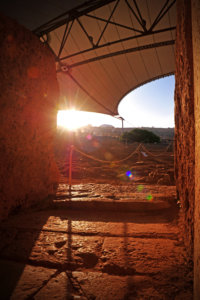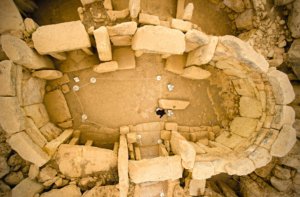Hagar Qim and Mnajdra Megalithic temples, together with the Ħal Saflieni Hypogeum, are two of the most popular prehistoric sites on the islands. These sites, together with five other temples, are unique to the Mediterranean and the whole world, and hence are two of the must-visit sites of anyone who visits the islands, irrespective of how short their stay is. More than a thousand years older than the pyramids and Stonehenge these temples started being built on the islands around 5,000 years ago. And, although the islanders had contact with the outside world, as evidenced by remains of obsidian and green stone pendants (raw materials not naturally available on the islands), it seems that these temples developed independently with no influence from other structures being built in other foreign lands.
Another feature which continues to add to the extra-ordinariness of these structures is the fact that they are built in such a way that during the first day of each season the sunrise illuminates part of the entrance of the temples. Whether this was purposely done or not we cannot be 100% sure, however, the precision and methodical way these structures were built indicates that intentionality was highly likely. Keeping in mind that seasonal changes would have meant also the need to harvest and plant seasonal crops and, how prehistoric agricultural societies depended on natural resources for their survival, such a solar calendar would have been very useful indeed. The latter indicates that, although the islanders who built these temples had primitive means, they were by no means unintelligent.

Mnajdra temple during solstice
Amongst the most important discoveries at Hagar Qim and Mnajdra megalithic temples we find a bevy of human figures. A good part of the latter have been found headless, full figured and almost completely naked. Whether these represented gods, goddesses, priests, worshippers or were simply ornamental figures we simply do not know yet. And although we call these structures temples even the fact of whether they were actually temples or simply administrative structures is something which is hotly debated by scholars. Another question which is frequently asked is whether human sacrifice was ever practised in those temples as some popular local poems and stories suggests. The answer to the latter is no, at least, so far, no remains indicating human sacrifices have been uncovered!

Temple apse
So what is it that we can tell for certain about these temples? One is that they must have held an important function, one that gathered to it a number of people on particular occasions and two is what the architecture of these temples so blatantly makes clear, that is, the incredible building skills these people had. So clear is this that these two sites, together with the other megalithic temple sites were inscribed on the Unesco World Heritage site list. Hagar Qim and Mnajdra megalithic temples were added on their merit of being “an outstanding example of a type of building, architectural or technological ensemble or landscape which illustrates (a) significant stage(s) in human history”. When one remembers that these people did not have metal tools or any of the machinery available nowadays to erect these megalithic structures, this feat becomes even more impressive. The inability to understand how such massive buildings could have been built by simple humans has, in fact, led some past scholars, such as Gian Frangisk Abela who was a Maltese academic living during the time of the Knights, to believe that they must have in fact been built by giants. The latter, is only one of the many myths and mysteries that surrounds these temples, one that will continue to attract thousands of yearly visitors.